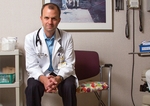Government
Health IT chief: Public-private partnership needed for EMRs
■ The foundation for a national health information technology infrastructure will be laid in communities, says David Brailer, MD, PhD.
By Joel B. Finkelstein — Posted July 26, 2004
- WITH THIS STORY:
- » Raising the bar
- » Related content
Washington -- When it comes to adopting information technology, the medical community is behind the curve. David Brailer, MD, PhD, wants to help physicians catch up. And he's calling on the private sector to assist him in the task.
Just months after being appointed as the national coordinator for health information technology, Dr. Brailer was making appearances to urge the designers and sellers of electronic medical records systems to focus more attention on the little guys.
"I have had every major consulting firm in the United States come to me in the past month and tell me about their capabilities," he recounted at a conference in June. "I ask every one of them the same question: There are 300,000 physicians in small or group practice. How many of them have you helped implement [electronic medical records]?
"The answer is usually somewhere between zero and five," he said. "Then I ask them: How many would you sign up if I asked you to do that as [the government's] partner, and the answer is usually between five and 10."
Named to his position in May, Dr. Brailer is charged with working toward the formidable health care IT goals of the Bush administration. President Bush has said he wants most Americans to have a personal electronic medical record within 10 years.
Health and Human Services Secretary Tommy Thompson said he is pushing for rapid adoption of information technology to make up for lost time. The benefits would be improved health care safety, quality and efficiency, he said.
So the pressure is on Dr. Brailer, and Dr. Brailer will be pressing physicians, hospitals and technology vendors to work together toward that end.
"Work harder, work faster," he told a roomful of community health care leaders at the June conference. "If you need more encouragement to work harder, faster, I will send you one of the voice mails I get from the secretary often saying exactly those words."
Overcoming barriers
Physicians are no strangers to technology. Sophisticated computer systems are used extensively in everything from drug development, laboratory testing, high-tech imaging techniques and surgery. But information technology has consistently been relegated to second-tier status, he said.
This could be due in part to bad past experiences because much of the available technology is designed with large institutions in mind and has not been well-adapted to the highly variable terrain of small physician practices.
"We have this very asymmetric market, and that results in something that I think harms both the buyers and the seller, which is that we have a very high failure rate of implementation," Dr. Brailer said.
The capital needed to invest in information systems is usually in short supply for solo physicians and small group practices. Vendors have focused too little attention on creating systems that fit in with a small office budget, he said.
Some vendors are working to scale down applications and financing for small entities.
For example, Misys Healthcare Systems, which provides health care information systems and electronic medical records to physician organizations, is developing all-inclusive packages that are billed per physician, per month, said Marc Winchester, senior vice president of market development.
Time is also a substantial obstacle, Winchester said.
Many physicians have enough trouble keeping up with daily patient case loads without spending hours training and learning a new computer system.
One way to address these problems, Dr. Brailer said, is to involve communities in the adoption of health information technology.
According to Winchester, "up to this point, most of the pressure has been on physicians and vendors."
Payers and purchasers of health care might start to feel that same pressure soon, as Dr. Brailer increasingly calls on health plans and businesses to partner with public entities to front some of the money that doctors need to purchase computerized systems that benefit entire communities.
"We envision the doctors and hospitals in a region having a regional health information network that allows their information to be shared securely between them as they need it for patient care," he said.
And once that happens, regional systems can begin interconnecting and growing into a national network, Dr. Brailer added.
Ultimately, this will result in better care for patients and a more satisfying work environment for physicians.
"This is not about technology for technology's sake. It's about better communication, about better alignment, about having access to knowledge when you need it, to have a holistic view of the patient," he said.
Privacy shouldn't be sidelined
As Dr. Brailer pushes forward with these efforts, one question still lingers for some experts: With the spread of information sharing, how will patients' privacy be protected?
"So far, privacy has been a 'by-the-way' issue," said Anna Slomovic, senior fellow at the Electronic Privacy Information Center. Officials have yet to answer how technology will be used to secure patient information.
Dr. Brailer suggested that his office would continue to rely on techniques already available under the Health Insurance Portability and Accountability Act.
"If you look at the HIPAA legislation that was passed, it very carefully balanced the need to protect privacy against the uses of information in patient care or in research or in monitoring the quality of care," he said. "Our goal is to respect and use that balance, not to change it."
Slomovic said her group would monitor the government's progress and assess if those protections were adequate.












